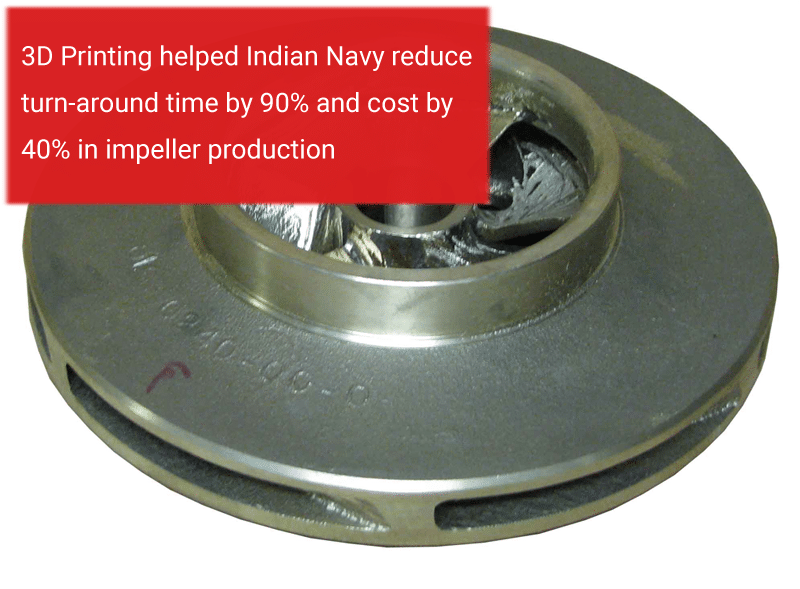3D Printing is a revolutionary technology that is going to transform the way product manufacturing is done in future. There is no perfect illustration for the same than the recent project think3D has done for Indian Navy to solve Navy’s long pending need for quick replacement of centrifugal pump impellers onboard the ships.
WHAT IS AN IMPELLER
Impeller is a rotating component of a centrifugal pump which transfers energy from the motor that drives the pump to the fluid being pumped by accelerating the fluid outwards from the center of rotation. The velocity achieved by the impeller transfers into pressure when the outward movement of the fluid is confined by the pump casing.
In simple words, it is a component used to pump liquids from a lower elevation to a higher elevation. In ships it is used to transfer liquid from sea to the various sections of the ship for regular water needs. The impellers come in different shapes and sizes depending on the amount of liquid to be pumped and these rotate at very high speeds for long periods.
PROBLEM STATEMENT
Major problem Navy is facing is the breakdown of these impellers due to displacement of the eye of impeller during rotation and due to foreign particles in the sea hitting the impeller. This is a common occurrence esp. when these impellers rotate at high speeds for longer time periods. Replacement parts for these impellers have to be manufactured using sand casting process and it takes around 3 months turn-around time to manufacture a new impeller. Each ship has multiple such pumps and thus multiple such impellers and constant breakdowns of these are creating a major impediment to Navy in carrying out their regular tasks. Navy is looking for an alternative solution where these impellers can be produced quickly and at a lower cost of ownership.
OUR SOLUTION
Vizag Navy has reached to think3D for solution to their problem. think3D team spent few days with the Navy team to understand the problem statement in detail, visited the ships to see in real various forces acting on the impellers and collected few data sheets on material properties required and boundary conditions. Based on the initial discussions, think3D has come up with few steps to solve the problem as illustrated below.
3D SCANNING & REVERSE ENGINEERING
As a first step, think3D did 3D Scanning & Reverse Engineering of the impeller using its state of art 3D Scanning & Reverse Engineering facility. think3D used EinScan Pro+ 3D Scanner to scan the impeller and used CREO to create the CAD model based on the 3D scanned data.
FINITE ELEMENT ANALYSIS
Using ANSYS software, think3D did FEA analysis of the impeller by using the boundary conditions and changing the material properties to see which material and which 3D Printing process best fits the bill. Various materials like nylon composites, glass filled nylon, PA12, other regular plastics are tested for suitability. One most important requirement for the impeller material is damping property. Damping is the ability of the material to convert vibrational energy into other forms of energy (generally heat) without the part breaking apart. Also, the part should have elasticity to withstand the vibrations. This ruled out various high strength materials as they are highly brittle and we finalized one particular (confidential) material for the part as it has good damping property and elasticity.
CAD DATA MODIFICATION
In the pump design, a metal rod is inserted into the eye of the impeller and this metal rod gives the impeller the required torque for rotating the impeller. Since the material is of plastic, metal rod shall quickly eat away the part. To avoid this issue additional material is added at the eye of the impeller. This additional material will be then machined in CNC and metal bushings will be inserted.
3D PRINTING OF IMPELLER
think3D used MJF technology from HP to 3D Print the part. The settings are thoroughly analyzed and modified to print the part with desired mechanical properties. The part is then CNC machined and metal bushing is inserted to create an interface between metal rod and plastic component. The part is tested in the real environment and it seems working fine for the desired number of hours.
Left – Original; Right – 3D Printed Replica
CONCLUSION
A part that would take 3 months to manufacture just took 2 days to manufacture using 3D Printing and also the total cost of ownership is 40% lower for 3D Printed part when compared to traditionally manufactured part. Another add-on benefit of 3D Printing the impeller is reduction in overall weight. The actual metal impeller used to weight 8 kgs to 9 kgs whereas the 3D Printed one weighed just 1 kg. This would reduce the overall weight of the ship leading to better fuel efficiency.
NEXT STEPS:
With the successful completion of 3D Printed impeller, think3D is now building a digital repository of impellers for Indian Navy. Once the repository is built, think3D shall 3D Print the required impeller on demand and supply to the Navy, a supply chain management process unforeseen so far for physical goods.
OUTLOOK:
This case study perfectly illustrates how 3D Printing coupled with 3D Scanning can be hugely beneficial for organizations in multiple departments. Spare parts management is a major cost component for many organizations. With 3D Scanning, a digital repository of spare parts can be maintained and the required component can be printed on demand leading to huge cost savings. Secondly, companies can easily develop lower cost alternatives to the existing parts. If you have any 3D Printing related requirements, feel free to contact us at info@think3d.in






3 replies on “think3D helped Indian Navy solve its pressing problem”
Good job think 3d..heard you people are doing amazing things👍
Dear Mr.Jhon, Thanks for your valuable comment. We will be looking forward to you.
excellant. lets connect.
sabujdip@yahoo.com